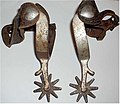Spur (riding)
A spur (plur .: the spurs ) is a bent piece of metal attached to the riding boot with a spike or wheel that is used when riding to support the thigh aids. The spur can be used in two different ways: On the one hand, the spur enables much more precise signaling than the large-area and therefore rather diffuse leg pressure. In this type of application it is used to refine riding. On the other hand, the spur can also be used as a means of coercion if the horse is insubordinate.
Depending on how they are attached to the boot, a distinction is made between buckle spurs (attached by means of straps around the instep and in front of the heel), lapel spurs (guide and receiving hole in the heel into which a spur with a corresponding pin is inserted) and stop spurs (fixed attachment).
Golden spurs used to be the symbol of knighthood , the owner of which was therefore also referred to as the knight of the golden spur . They often appear as knight insignia on tombstones and in coats of arms.
nature
The length of the spurs varies from 5 mm to several centimeters and depends on the riding style and the size ratio of horse and rider. For the riding of (in relation to the rider) rather small horses, the use of so-called gooseneck spurs is recommended, in which the spike is guided upwards in a gooseneck-like double bend in order to allow the rider to touch the horse without pulling up the heel. Sharp spores can cause bleeding injuries, but blunt spores can also cause trauma under the skin. In the past (medieval knights), spurs with sharp points were also used. In South America you can still find them today. In Europe and North America such spurs are not common and are not allowed in tournaments.
In English riding or dressage riding , the lower legs are on the saddle girth. A spur with a short spike is usually used here, which is worn in the heel area of the riding boot. Wheel spurs are also used. The wheels protrude only a few millimeters above the spine, the prongs are flat or missing entirely.
In western riding you ride with your legs outstretched. Here one uses the usually longer spurs with star wheels (wheels with blunt teeth), which are attached to the heel of the western boots. In western tournaments, these star spurs are part of the required standard equipment. Contrary to popular belief, the larger the wheel, the gentler the spurs, as a larger wheel rolls more easily on the horse's body. The spurs with large wheels sometimes shown in Western films are therefore only particularly sharp if they have pointed, pointed teeth. The fact that western spurs usually ring also has a function: with a well-trained, finely tuned and consistently ridden horse, ideally, you don't have to use your leg at all, but the horse already reacts to the ringing of the spurs. However, only a few horses achieve this high level of training and only with an excellent rider.
Box stirrups are sometimes used instead of spurs in the Iberian riding style .
use
Spores are used on sensitive areas of the abdominal skin. The use of spurs is therefore reserved for advanced riders, as a rider with an unsteady seat and restless legs can cause constant unwanted use of spurs, which can cause irritation and possibly injuries in the horse. This creates "spore holes" in the fur or even sores on the skin. The horse must also be trained accordingly so that it can correctly interpret the spur aids.
Spores can be used in different ways.
The most common is the use for drifting. To do this, the spur is inserted just behind the belt. However, that's not the real idea behind the spurs. The spurs are supposed to refine the rider's aids by setting a short impulse. As soon as the horse reacts accordingly, the use of the spurs should be stopped ( negative reinforcement ). A short, clear help, followed by a reaction, is more effective than a regular dull (numbing) knocking of the heel on the horse's belly.
The second application is taught in classical dressage and is called the effet d'ensemble . The effet d'ensemble has a gathering effect, that is, it acts as a brake. To do this, the spur is used as far in front as possible, directly behind the belt. For a well-trained couple, all it takes is the twist of the thighs necessary to bring the spur to the horse in order to bring the horse together.
Phrase
The saying "earn one's spurs" goes back to the custom that a medieval European squire received a pair of spurs when he was ordained a knight ( accolade ) as a sign of his knighthood. Together with the sword, these served as the official identification mark of the knighthood. But these insignia first had to be "earned" through personal probation in a battle or a tournament ( Buhurt , Tjost ). Today you have to earn your spurs through skill, as spurs may only be used if you have mastered a calm and correct position of the thighs, as well as independent assistance in all situations.
Spurs in heraldry
Spurs are a common figure in heraldry and are represented in the coat of arms by a U-shaped fork with a tail wheel . All heraldic tinctures are possible, but the metals gold and silver are preferred. There are seldom more than two spurs in the coat of arms. There is no heraldic penetration, so that every location in the coat of arms or field should be described.
See also
Web links
Individual evidence
- ↑ Duden 11, 1992, page 675







